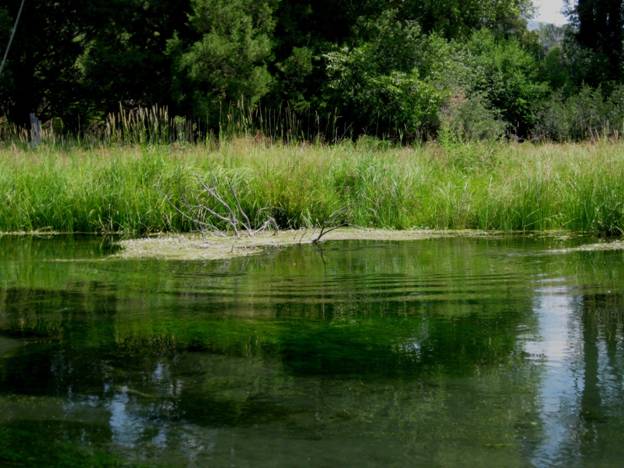LOCATION, LOCATION, LOCATION – PART 2
Last week I present four different scenarios that are commonly encountered by a fly-fisher angling for trout on a stream. This piece was intended to generate some discussion among my readership, and cause everyone that read the piece to think about how they would approach each situation and why. It’s also a sneaky way to see if anyone is actually reading this stuff.
Before I begin to give you my solutions to each angling situation I need to make it clear that there may be more than one way to approach each fish, and I am only going to relate how I would approach them. These approaches are based on years of experience with fish located in similar situations, but my solutions are not necessarily the only ones that will produce results.
The first fish was holding against the bank below some strands of grass that were trailing in the water creating a series of currents that disrupted the even flow of the stream. The trout, a respectable brown, was holding in a depression next to the bank and was occasionally tipping up and taking something from the surface. There were a number of different insects floating down on the current including mayflies, caddis flies and terrestrials.

A bank side riser in a tough place
Fish holding in this type of situation represent one of the more challenging situations in fly-fishing for trout. The sporadic nature of the rise and the variety of insects available on the surface film add to the difficulty.
There are several issues that make this particular trout a difficult target for the angler. First, the fish is holding in relatively shallow water where it is exposed to attack from above. This makes a trout holding in this type of situation extremely wary and likely to bolt for deep water at the slightest hint of danger. A careless cast, a dragging fly, a shadow or flash of light from a fly rod or line may send the fish scurrying. Once spooked such a fish is unlikely to return to that position for a long period of time. The trout is only rising sporadically and apparently to nothing specific, and this means that the angler may have to make several perfect casts before the trout may rise. The strands of grass trailing in the water increase the difficulty of accomplishing this task.
To narrow the odds I would opt to get below the trout and sample the flies that are coming down in the current. Since it appears that the trout is feeding on insects in or on the surface film I would concentrate on trying to determine which type of insect was the most plentiful and use an imitation that most closely imitated that insect. To accomplish this I would go a good distance below the place where the trout was holding, and wade very carefully into position to avoid spooking my quarry.
My approach to the trout would be either slightly downstream or directly across from where the fish was holding. My choice would be determined by the width of the stream at the point where the trout was holding. In a narrow stream casting directly across from the trout would likely spook it, whereas in a wider stream that would not be the case. Approaching from downstream limits my presentation options but keeps me slightly behind the trout where it is less likely to detect me. Whichever position I choose I would make certain that I did not make a cast directly over the fish.
First I will grease my leader to make certain that the entire leader floats. I don’t want the leader to get sucked down by the twisting currents and thus induce drag on my fly. [This may cause some of you to be concerned about the trout ‘seeing the leader’ but the trout that I fish for are not smart enough to connect the dots between a thin shadow on the surface and a leader] I would also try to see if I could establish any regularity to the trout’s rising and attempt to time my presentations appropriately.
Next I would measure out my cast by placing a cast next to the fish but far enough out in the stream to avoid spooking the fish. Once I was satisfied that I had sufficient line out to reach the target I would be ready to make an attempt to place a cast to the fish holding next to bank.
Casting from below and slightly to the side of the fish I could use a puddle cast or a slack line cast to allow the fly to float over the fish without drag. Since insects coming into the trout’s cone of vision would only be visible after they had drifted passed the trailing strands of the grass the drift would only have to be relatively short to allow the fish to see the fly. This short distance would reduce the chance of the fly dragging over the trout. The amount of slack that I would need would be dependent upon the speed of the main current flow, but under all circumstances the fly would have to land consistently downstream from the strands of grass with only the tippet in the current flowing over the trout.
If the stream was wide enough to allow an across stream approach I could use a greater variety of casts. I could still use the puddle or slack line cast but I could also use a reach cast and even some short mends to eliminate the chance of dragging the fly across the fish. This is the position that I prefer when trying for a trout holding in this type of position.
Now that you’ve read my approach what’s yours?
Next week we will cover the other angling situations.
